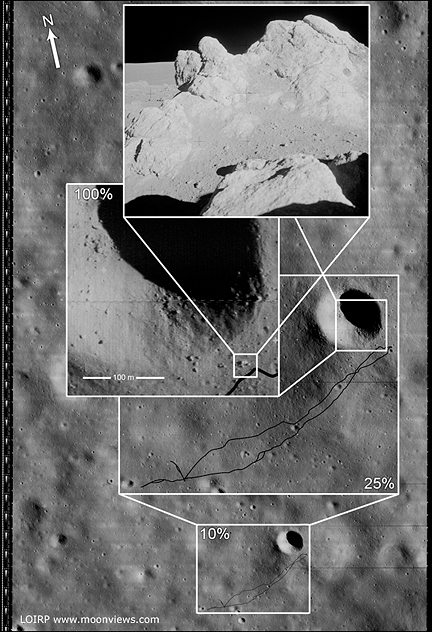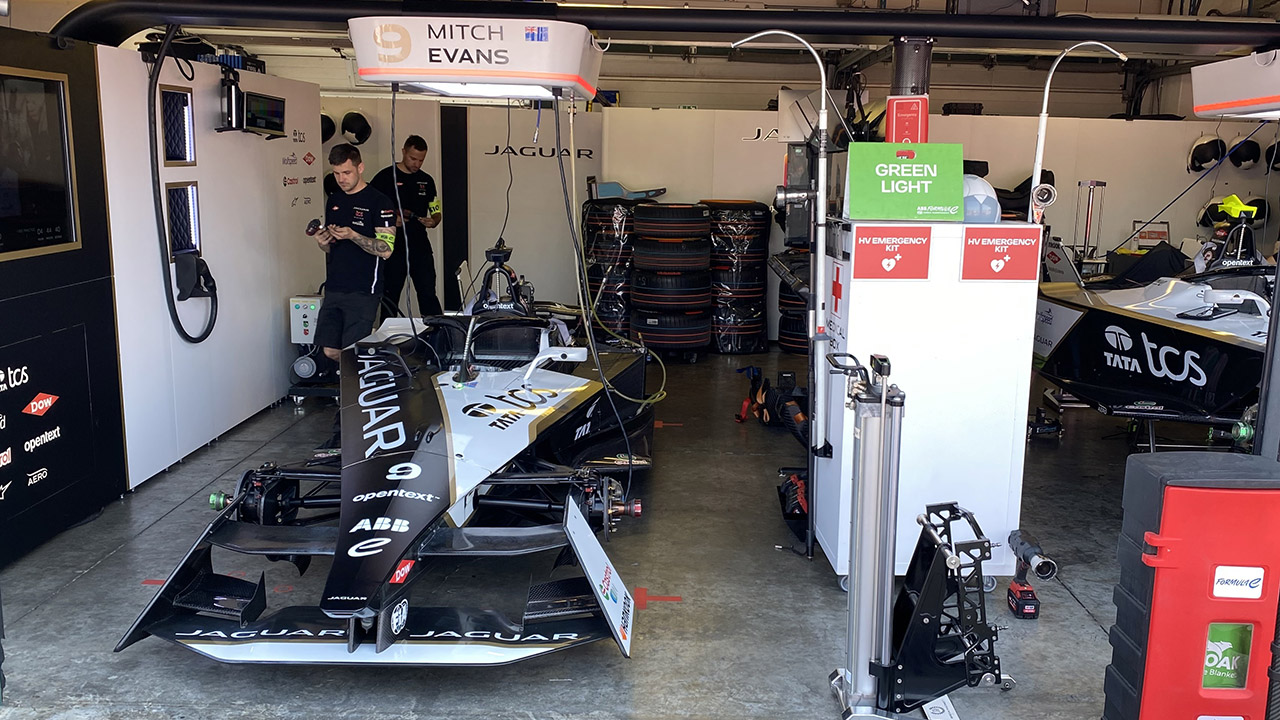|
|||||||
|
|
|
 |
|
|
Strumenti |
|
|
#161 |
|
Senior Member
Iscritto dal: Mar 2004
Città: Napoli
Messaggi: 10243
|
ottimo!! speriamo che la missione nn venga chiusa prima del previsto per mancanza di fondi (avevo letto una cosa del genere circa un anno fa' , adesso com'è la situazione??)
__________________
Argenio Napoli | VENDO VARIE | Le Mie Trattative (45) Hp Envy 32" 1440p/i7 4790k/Intel Hd 4600/16 gb Ram/SSD 256gb + WD 2x3tb/XFX 750watt |
|
|

|
|
|
#162 |
|
Senior Member
Iscritto dal: Nov 2001
Città: Padova
Messaggi: 1635
|
no no, con quel poco che costano, sono si è no una decina di persone in tutto. I tagli riguardavano altre missioni, se ricordo bene, a cominciare dalla cancellazione di Jupiter Icy Moon Orbiter del programma Prometheus per le missioni con sonde a propulsione nucleare.
__________________
Cosmos Pure | Core i7 860 | P7P55D-E Deluxe | 16GB DDR3 Vengeance | HD5850 | 2x850PRO 256GB | 2xRE3 250GB | 2xSpinPoint F3 1TB |
|
|

|
|
|
#163 | |
|
Senior Member
Iscritto dal: Feb 2002
Città: Trento
Messaggi: 961
|
Quote:
__________________
"Et Eärallo Endorenna utúlien. Sinome maruvan ar Hildinyar tenn' Ambar-metta!" -- Aragorn Elessar, Heir of Isildur Mixmar -- OpenSuSE 11.1 on AMD 64 3000+ on DFI LanParty nF4-D | GeForce 6600 GT + Thermaltake Schooner on Samsung 710N Storage -- ( 2 x Hitachi Deskstar 80 Gb + 1 x Hitachi 250 Gb ) = 1 RAID 5 + 1 Storage space LaCie Ethernet Disk Mini 250 Gb | HP - DV2150 EL MILAN CLAN |
|
|
|

|
|
|
#164 |
|
Senior Member
Iscritto dal: Nov 2001
Città: Padova
Messaggi: 1635
|
SMART-1 on the trail of the Moon's beginnings
EUROPEAN SPACE AGENCY NEWS RELEASE Posted: August 22, 2006 The D-CIXS instrument on ESA's Moon mission SMART-1 has produced the first detection from orbit of calcium on the lunar surface. By doing this, the instrument has taken a step towards answering the old question: did the Moon form from part of the Earth? 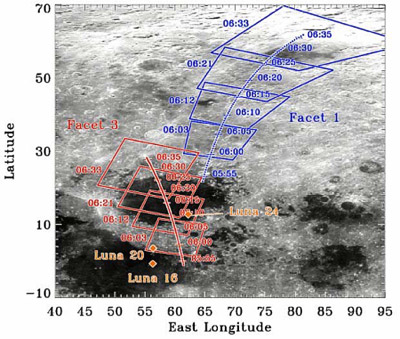 Scientists responsible for the D-CIXS instrument on SMART-1 are also announcing that they have detected aluminium, magnesium and silicon. "We have good maps of iron across the lunar surface. Now we can look forward to making maps of the other elements," says Manuel Grande of the University of Wales, Aberystwyth UK, and D-CIXS' Principal Investigator. Knowing how to translate the D-CIXS orbital data into Œground truth' has been helped by a cosmic coincidence. On 9 August 1976, the Russian spacecraft Luna 24 was launched. On 18 August it touched down in a region of the Moon known as Mare Crisium and returned a sample of the lunar soil to Earth. In January 2005, SMART-1 was high above Mare Crisium when a giant explosion took place on the Sun. Scientists often dread these storms because they can damage spacecraft but, for the scientists responsible for D-CIXS, it was just what they needed. The D-CIXS instrument depends on X-ray emission from the Sun to excite elements on the lunar surface, which then emit X-rays at characteristic wavelengths. D-CIXS collects these X-ray fingerprints and translates them into the abundance of each chemical element found on the surface of the Moon. Grande and his colleagues could relate the D-CIXS Mare Crisium results to the laboratory analysis of the Russian lunar samples. They found that the calcium detected from orbit was in agreement with that found by Luna 24 on the surface of Mare Crisium. As SMART-1 flew on, it swept D-CIXS over the nearby highland regions. Calcium showed up here too, which was a surprise until the scientists looked at the data from another Russian moon mission, Luna 20. That lander had also found calcium back in the 1970s. This boosted the scientists' confidence in the D-CIXS results. Ever since American astronauts brought back samples of moonrock during the Apollo Moon landings of the late 1960s/early 1970s, planetary scientists have been struck by the broad similarity of the moonrocks and the rocks found deep in the Earth, in a region known as the mantle. This boosted the theory that the Moon formed from debris left over after the Earth was struck a glancing blow by a Mars-sized planet. However, the more scientists looked at the details of the moonrock, the more discrepancies they found between them and the earthrocks. Most importantly, the isotopes found in the moonrocks did not agree with those found on Earth. "The get-out clause is that the rocks returned by the Apollo missions represent only highly specific areas on the lunar surface and so may not be representative of the lunar surface in its entirety," says Grande; hence the need for D-CIXS and its data. By measuring the abundance of several elements across the lunar surface, scientists can better constrain the contribution of material from the young Earth and its possible impactor to condense and form the Moon. Current models suggest that more came from the impactor than from Earth. Models of the Moon's evolution and interior structure are necessary to translate the surface measurements into the Moon's bulk composition. D-CIXS was a small experimental device, only about the size of a toaster. ESA is now collaborating with India to fly an upgraded version on the Indian lunar probe Chandrayaan, due for launch in 2007*2008. It will map the chemistry of the lunar surface, including the other landing sites from where samples have been brought back to Earth. In this way it will show whether the Apollo and Russian landing sites were typical or special. "From SMART-1 observations of previous landing sites we can compare orbital observations to the ground truth and expand from the local to global views of the Moon," says Bernard Foing, Project Scientist for SMART-1. Then, perhaps planetary scientists can decide whether the Moon was indeed once part of the Earth. The findings will appear in the Planetary and Space Science journal, in an article titled: "The D-CIXS X-ray spectrometer on the SMART-1 mission to the Moon * First Results", by M.Grande et al. 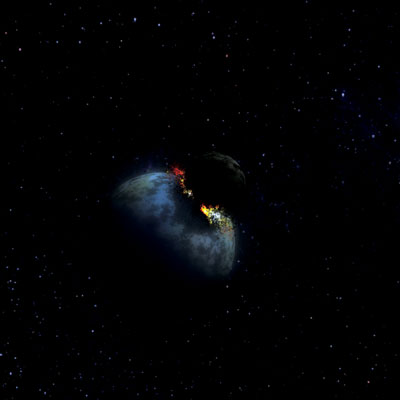
__________________
Cosmos Pure | Core i7 860 | P7P55D-E Deluxe | 16GB DDR3 Vengeance | HD5850 | 2x850PRO 256GB | 2xRE3 250GB | 2xSpinPoint F3 1TB |
|
|

|
|
|
#165 |
|
Senior Member
Iscritto dal: Nov 2001
Città: Padova
Messaggi: 1635
|
Da La Repubblica.it:
La decisione presa dal congresso internazionale Iau in corso a Praga Pochi giorni fa erano stati promossi invece Cerere, Caronte e Xena Gli astronomi declassano Plutone solo otto i pianeti del sistema solare Il corpo celeste è stato "retrocesso" a "pianeta nano" per ragioni di grandezza Scoperto nel 1930, mai visitato da una sonda, è il più lontano dal sole PRAGA - Plutone retrocede, diventa "pianeta nano" e va nella stessa categoria di Cerere, Caronte e 2003 UB313 (Xena): grandi asteroidi "promosse" nei giorni scorsi. Il sistema solare secondo gli astronomi della Iau (Unione astronomica internazionale) riuniti in questi giorni a Praga è ora formato da otto pianeti "classici": Mercurio, Venere, Terra, Marte, Giove, Urano e Nettuno in ordine di distanza dal Sole. Poi ci sono i 4 "nani". Come spiega Gianna Cauzzi da Praga "la proposta di includere Cerere, Xena e Caronte tra i pianeti era stata presentata (e non decisa) la scorsa settimana, ma non ha trovato supporto, anche in virtu' del fatto che grazie a nuovi strumenti e tecnologie, probabilmente in pochi anni ci ritroveremo con dozzine di nuovi corpi celesti di questo tipo". Il declassamento di Plutone è stato dettato dalle sue dimensioni troppo piccole (il suo diametro medio è di circa 2306 chilometri). I miglioramenti nelle osservazioni spaziali stanno permettendo infatti agli scienziati di scoprire l'esistenza di molti altri corpi celesti della grandezza simile a quella dell'ex pianeta e da qui l'esigenza di introdurre la categoria dei "pianeti nani". Scoperto nel 1930 e battezzato in onore della divinità romana dell'oltretomba, Plutone è il pianeta più distante dal sole e l'unico a non essere mai stato visitato da una sonda. Molte misurazioni sono quindi approssimative e non confermate. La sua debole atmosfera è composta prevalentemente da metano gassoso, argon, azoto, monossido di carbonio e ossigeno. La sua superficie, composta da ghiaccio d'acqua e di metano, non è uniforme, come dimostrano le sensibili variazioni di albedo (la quantità di luce riflessa indietro) riscontrabili da Terra nel corso della sua rotazione. Da tempo la natura di Plutone era al centro del dibattito astrofisico. Una parte di scienziati ipotizza infatti che possa essere un grosso asteroide della fascia di Kuiper, intuizione rafforzata quando è stato scoperto un asteroide appartenente a questa fascia con un diametro di ben 1000 km, circa la metà di Plutone. Prima del declassamento Plutone oltre a essere classificato come pianeta era anche considerato il maggiore dei corpi della fascia di Kuiper.
__________________
Cosmos Pure | Core i7 860 | P7P55D-E Deluxe | 16GB DDR3 Vengeance | HD5850 | 2x850PRO 256GB | 2xRE3 250GB | 2xSpinPoint F3 1TB |
|
|

|
|
|
#166 |
|
Senior Member
Iscritto dal: Nov 2001
Città: Padova
Messaggi: 1635
|
Da Space.com:
Pluto Demoted: No Longer a Planet in Highly Controversial Definition By Robert Roy Britt Senior Science Writer posted: 24 August 2006 09:35 am ET Capping years of intense debate, astronomers resolved today to demote Pluto in a wholesale redefinition of planethood that is being billed as a victory of scientific reasoning over historic and cultural influences. But already the decision is being hotly debated. Officially, Pluto is no longer a planet. "Pluto is dead," said Caltech researcher Mike Brown, who spoke with reporters via a teleconference while monitoring the vote. The decision also means a Pluto-sized object that Brown discovered will not be called a planet. "Pluto is not a planet," Brown said. "There are finally, officially, eight planets in the solar system." The vote involved just 424 astronomers who remained for the last day of a meeting of the International Astronomical Union (IAU) in Prague. "I'm embarassed for astornomy," said Alan Stern, leader of NASA's New Horizon's mission to Pluto and a scientist at the Southwest Research Institute. "Less than 5 percent of the world's astronomers voted." "This definition stinks, for technical reasons," Stern told SPACE.com. He expects the astronomy community to overturn the decision. Other astronomers criticized the definition as ambiguous. The resolution The decision establishes three main categories of objects in our solar system. Planets: The eight worlds from Mercury to Neptune. Dwarf Planets: Pluto and any other round object that "has not cleared the neighborhood around its orbit, and is not a satellite." Small Solar System Bodies: All other objects orbiting the Sun. Pluto and its moon Charon, which would both have been planets under the initial definition proposed Aug. 16, now get demoted because they are part of a sea of other objects that occupy the same region of space. Earth and the other eight large planets have, on the other hand, cleared broad swaths of space of any other large objects. "Pluto is a dwarf planet by the ... definition and is recognized as the prototype of a new category of trans-Neptunian objects," states the approved resolution. BLOG Pluto’s Demotion is Well Deserved and Long Overdue Dwarf planets are not planets under the definition, however. "There will be hundreds of dwarf planets," Brown predicted. He has already found dozens that fit the category. Contentious logic The vote came after eight days of contentious debate that involved four separate proposals at the group's meeting in Prague. The initial proposal, hammered out by a group of seven astronomers, historians and authors, attempted to preserve Pluto as a planet but was widely criticized for diluting the meaning of the word. It would also have made planets out of the asteroid Ceres and Pluto's moon Charon. But not now. "Ceres is a dwarf planet. it's the only dwarf planet in the asteroid belt," Brown said. "Charon is a satellite." The category of "dwarf planet" is expected to include dozens of round objects already discovered beyond Neptune. Ultimately, hundreds will probably be found, astronomers say. The word "planet" originally described wanderers of the sky that moved against the relatively fixed background of star. Pluto, discovered in 1930, was at first thought to be larger than it is. It has an eccentric orbit that crosses the path of Neptune and also takes it well above and below the main plane of the solar system. Recent discoveries of other round, icy object in Pluto's realm have led most astronomers to agree that the diminutive world should never have been termed a planet. 'A farce' Stern, in charge of the robotic probe on its way to Pluto, said the language of the resolution is flawed. It requires that a planet "has cleared the neighborhood around its orbit." But Earth, Mars, Jupiter and Neptune all have asteroids as neighbors. "It's patently clear that Earth's zone is not cleared," Stern told SPACE.com. "Jupiter has 50,000 trojan asteroids," which orbit in lockstep with the planet. Stern called it "absurd" that only 424 astronomers were allowed to vote, out of some 10,000 professional astronomers around the globe. "It won't stand," he said. "It's a farce." Stern said astronomers are already circulating a petition that would try to overturn the IAU decision. Owen Gingerich, historian and astronomer emeritus at Harvard who led the committee that proposed the initial definition, called the new definition "confusing and unfortunate" and said he was "not at all pleased" with the language about clearing the neighborhood. Gingerich also did not like the term "dwarf" planet. "I thought that it made a curious linguistic contradiction," Gingerich said in a telephone interview from Boston (where he could not vote). "A dwarf planet is not a planet. I thought that was very awkward." Gingerich added: "In the future one would hope the IAU could do electronic balloting." Years of debate Astronomers have argued since the late 1990s, however, on whether to demote Pluto. Public support for Pluto has weighed heavily on the debate. Today's vote comes after a two-year effort by the IAU to develop a definition. An initial committee of astronomers failed for a year to do so, leading to the formation of the second committee whose proposed definition was then redefined for today's vote. Astronomers at the IAU meeting debated the proposals right up to the moment of the vote. Caltech's Mike Brown loses out in one sense. The Pluto-sized object his team found, called 2003 UB313, will now be termed a dwarf planet. "As of today I have no longer discovered a planet," he said. But Brown called the result scientifically a good decision. "The public is not going to be excited by the fact that Pluto has been kicked out," Brown said. "But it's the right thing to do." Textbooks will of course have to be rewritten. "For astronomers this doesn't matter one bit. We'll go out and do exactly what we did," Brown said. "For teaching this is a very interesting moment. I think you can describe science much better now" by explaining why Pluto was once thought to be a planet and why it isn't now. "I'm actually very excited.
__________________
Cosmos Pure | Core i7 860 | P7P55D-E Deluxe | 16GB DDR3 Vengeance | HD5850 | 2x850PRO 256GB | 2xRE3 250GB | 2xSpinPoint F3 1TB |
|
|

|
|
|
#167 |
|
Senior Member
Iscritto dal: Jun 2005
Città: Pesaro - Distretto dei Colli e dei Castelli
Messaggi: 301
|
Quanto son contento!!!!
|
|
|

|
|
|
#168 | |
|
Senior Member
Iscritto dal: Jun 2003
Città: latina
Messaggi: 2363
|
Quote:
questo non lo avevano previsto     per caso si nota che mi stanno sulle balle? |
|
|
|

|
|
|
#169 |
|
Senior Member
Iscritto dal: Oct 2000
Città: UK
Messaggi: 7408
|
boh, mi par 'na stronzata... storicamente è stato considerato pianeta, che resti tale. Che fastidio dava? In fondo di sostanza ce n'è poca, era solo questione di definizioni...
__________________
"Questo forum non è un fottuto cellulare quindi scrivi in italiano, grazie." (by Hire) Le mie foto su Panoramio - Google Earth |
|
|

|
|
|
#170 |
|
Senior Member
Iscritto dal: Nov 2001
Città: Padova
Messaggi: 1635
|
Mars Global Surveyor may be at mission's end
NASA NEWS RELEASE Posted: November 21, 2006 NASA's Mars Global Surveyor has likely finished its operating career. The spacecraft has served the longest and been the most productive of any mission ever sent to the red planet. "Mars Global Surveyor has surpassed all expectations," said Michael Meyer, NASA's lead scientist for Mars exploration at NASA Headquarters, Washington. "It has already been the most productive science mission to Mars, and it will yield more discoveries as the treasury of observations it has made continues to be analyzed for years to come." Its camera has returned more than 240,000 images to Earth. The orbiter has not communicated with Earth since Nov. 2. Preliminary indications are that a solar panel became difficult to pivot, raising the possibility that the spacecraft may no longer be able to generate enough power to communicate. Engineers are also exploring other possible explanations for the radio silence. "Realistically, we have run through the most likely possibilities for re-establishing communication, and we are facing the likelihood that the amazing flow of scientific observations from Mars Global Surveyor is over," said Fuk Li, Mars Exploration Program manager at NASA's Jet Propulsion Laboratory (JPL), Pasadena, Calif. "We are not giving up hope, though." Efforts to regain contact with the spacecraft and determine what has happened to it will continue. NASA's newest Mars spacecraft, the Mars Reconnaissance Orbiter, pointed its cameras towards Mars Global Surveyor on Monday. "We have looked for Mars Global Surveyor with the star tracker, the context camera and the high-resolution camera on Mars Reconnaissance Orbiter," said Doug McCuistion, Mars Exploration Program director at NASA Headquarters. "Preliminary analysis of the images did not show any definitive sightings of a spacecraft." The next possibility for learning more about Mars Global Surveyor's status is a plan to send it a command to use a transmitter that could be heard by one of NASA's Mars Exploration Rovers later this week. Mars Global Surveyor launched on Nov. 7, 1996, and began orbiting Mars on Sept. 11, 1997. It pioneered the use of aerobraking at Mars, using careful dips into the atmosphere for friction to shrink a long elliptical orbit into a nearly circular one. The mission then started its primary mapping phase in April 1999. The original plan was to examine the planet for one Mars year, nearly two Earth years. Based on the value of the science returned by the spacecraft, NASA extended its mission four times. "It is an extraordinary machine that has done things the designers never envisioned despite a broken wing, a failed gyro and a worn-out reaction wheel. The builders and operating staff can be proud of their legacy of scientific discoveries and key support for subsequent missions," said Tom Thorpe, project manager for Mars Global Surveyor at JPL. The spacecraft evaluated landing sites for the twin NASA rovers that landed in 2004 and sites for future landings of the Phoenix and Mars Science Laboratory missions. It monitored atmospheric conditions during aerobraking by newer orbiters. It served as a relay link for the rovers and provided mapping information about their surroundings. "When we watched the launch 10 years ago, we wondered if we would make the specified mission length. We certainly were not thinking of a 10-year operating life," said JPL retiree Glenn Cunningham, who managed the Global Surveyor project through development and launch. A few of the mission's many important discoveries about Mars include: - The spacecraft's camera found gullies cut into many slopes that have few, if any, impact craters. This indicates the gullies are geologically young. Scientists interpret this as evidence of action by liquid water, essentially in modern times. - The mineral-mapping infrared spectrometer found concentrations of a mineral that often forms under wet conditions, fine-grained hematite. This discovery led to selection of a hematite-rich region as the landing site for NASA's Mars Exploration Rover Opportunity. - Laser altimeter measurements have produced an unprecedented global topographic map of Mars. The instrument revealed a multitude of highly eroded or buried craters too subtle for previous observation, and mapped canyons within the polar ice caps. - The magnetometer found localized remnant magnetic fields, indicating that Mars once had a global magnetic field like Earth's, shielding the surface from deadly cosmic rays. - The camera found a fan-shaped area of interweaving, curved ridges interpreted as evidence of an ancient river delta resulting from persistent flow of water over an extended period in the planet's ancient past. - A long life allowed Global Surveyor to track changes through repeated annual cycles. For three Martian summers in a row, deposits of carbon-dioxide ice near Mars' South Pole shrunk from the previous year's size, suggesting a climate change in progress. - JPL manages Mars Global Surveyor for the NASA Science Mission Directorate, Washington.
__________________
Cosmos Pure | Core i7 860 | P7P55D-E Deluxe | 16GB DDR3 Vengeance | HD5850 | 2x850PRO 256GB | 2xRE3 250GB | 2xSpinPoint F3 1TB Ultima modifica di GioFX : 21-11-2006 alle 19:57. |
|
|

|
|
|
#171 |
|
Senior Member
Iscritto dal: Apr 2002
Città: VR-PD
Messaggi: 11025
|
Grazie di tutto Mars Global Surveyor Da dieci anni studiava la superficie del pianeta Il 3 novembre ha ricevuto una segnalazione allarme. E poi... La sonda Mars Global Surveyor non risponde più "Ormai l'abbiamo perduta" La sonda Mars Global Surveyor non risponde più "Ormai l'abbiamo perduta" di LUIGI BIGNAMI La Nasa ha utilizzato ogni mezzo per cercare la Mars Global Surveyor, che da 10 anni fotografa e studia la superficie del pianeta: ora è giunta alla conclusione che non c'è più nulla da fare. "La sonda è persa e come ad un vecchio amico, dobbiamo dirle addio", hanno detto i tecnici del Jet Propulsion Laboratori dell'Ente Spaziale Americano. Per cercarla, nelle ultime settimane la Nasa aveva scomodato anche l'ultima sonda lanciata attorno a Marte, la Mars Reconnaissance Orbiter, in grado di fotografare dettagli di Marte non più grandi di pochi centimetri, ma non c'è stato nulla da fare. La Mars Global Surveyor era stata lanciata nel 1996 dal Kennedy Space Center in Florida per una missione che prevedeva solo due anni di attività in orbita intorno a Marte. Un compito da umile gregario mentre tutti gli occhi del mondo erano puntati in quel periodo sulla sonda Pathfinder e il suo piccolo rover Sojourner che spediva foto di panorami mozzafiato dalla superfice del pianeta rosso. Ma giorno dopo giorno quei due anni sono diventati dieci. E in un decennio, Global Surveyor ha fotografato quasi tutta la superficie marziana, pezzo per pezzo, offrendo alla Nasa la possibilità di creare carte del pianeta rosso fino ad ora impensabili. Anche quando su Marte sono arrivate altre due 'primedonne', i rover Spirit e Opportunity, Mars Global Surveyor ha continuato nell'infaticabile lavoro di gregario in orbita, senza rinunciare però alla soddisfazione di cogliere a sua volta qualche foto da scoop. Come quelle di canyon e gole sui crinali di crateri che gli scienziati ipotizzano possano essere un segno della presenza di acqua di un lontano passato o la scoperta dei "gully", ossia vedute a giorno di acqua (questa è l'ipotesi principale anche se ne esistono altre) che crea dei piccoli torrenti che evaporano immediatamente. La sonda ha scoperto anche la testimonianza di un campo magnetico attivo nel passato e ha osservato l'evolversi dei poli da stagione in stagione. Da quando è cominciata la missione di Mars Global Surveyor, sono arrivate in orbita intorno a Marte altre tre sonde con strumenti più sofisticati (una di costruzione europea), oltre a Spirit e Opportunity (che stanno continuando a mandare informazioni e foto dalla superficie marziana). Ma la missione di Mars Global Surveyor che doveva cessare nel 1999 non si è mai interrotta e la Nasa ha premiato la sonda stanziando fondi che hanno permesso fino a oggi di mantenere in vita il programma. Adesso però si è giunti all'epilogo. Il 3 novembre gli scienziati del Jet Propulsion Laboratory di Pasadena, in California, hanno ricevuto dalla sonda un segnale che indicava problemi nell'orientare uno dei pannelli solari. I tecnici hanno risposto inviando istruzioni a Mars Global Surveyor, che sono state seguite da due giorni di silenzio e poi dall'indicazione, il 5 novembre, che la sonda era entrata in modalità 'safe', si era cioè autoibernata in attesa di nuovi ordini. Da allora, solo silenzio e nonostante i tentatvi per cercarla con gli strumenti di altre sonde di essa non si è più avuta traccia. "Dobbiamo consolarci, la sonda è morta. Solo un miracolo potrà permetterci di scoprire dov'è e di farla rivivere", ha detto Tom Thorpe, direttore della missione.
__________________
Ph'nglui mglw'nafh Cthulhu R'lyeh wgah'nagl fhtagn |
|
|

|
|
|
#172 |
|
Senior Member
Iscritto dal: Nov 2001
Città: Padova
Messaggi: 1635
|
Da SpaceFlightNow.com:
http://www.spaceflightnow.com/news/n0611/21mgs Hope fades for missing Mars Global Surveyor craft BY WILLIAM HARWOOD STORY WRITTEN FOR CBS NEWS "SPACE PLACE" & USED WITH PERMISSION Posted: November 21, 2006 NASA's $377 million Mars Global Surveyor, the oldest of four spacecraft currently in orbit around the red planet, apparently fell victim to what amounts to severe arthritis Nov. 2 when one of its two solar panels jammed and stopped tracking the sun. While the 10-year-old spacecraft may still be alive, hunkered down in electronic hibernation awaiting instructions from Earth, flight controllers have not been able to regain contact and fear the aging satellite may be lost, officials said today. "While we have not exhausted everything we could do ... we believe the prospect of recovery of MGS is not looking very good at all," said Fuk Li, Mars program manager at NASA's Jet Propulsion Laboratory in Pasadena, Calif. "However, MGS has been a good friend, it's had an illustrious career, the data it's collected has taught us a lot about Mars and it will continue to teach us a lot about Mars," Li told reporters in a teleconference. "We're certainly feeling that we might be losing a good friend from our family here. We're still holding out some hope, but we are fully prepared in our hearts that we may never be able to talk to the spacecraft again." The Mars Global Surveyor was launched Nov. 7, 1996. After a one-year cruise to Mars, the spacecraft braked into an elliptical orbit Sept. 11, 1997. To save money, MSG was not designed to carry enough fuel to brake directly into a circular mapping orbit. That would have required a more powerful launch vehicle, a larger spacecraft and a much higher price tag. Instead, the flight plan called for repeated dips into Mars' atmosphere to lower the high point of the initial orbit. That process should have taken four months or so to complete. But because of concern about the strength of one of the craft's two big solar panels, the so-called aerobraking maneuver was stretched out to a full year. MGS began studying Mars in earnest in April 1999. The original mission requirement was to map the surface of the planet for two years. NASA recently approved the mission's fourth two-year extension. But on Nov. 2 at 6:35 p.m. EST, when MGS emerged from behind Mars as viewed from Earth, telemetry indicated major problems with one of its solar arrays - the same array that caused concern when the spacecraft reached Mars in 1997. "In fact, the spacecraft had decided on its own to switch over to the backup electronics that drives the motor that moves the solar array and also to move to a redundant power bus on the spacecraft," Li said. "The spacecraft then regained its functions and performed nominally through the rest of the orbit. "Then it went behind Mars one more time and at about (8:27 p.m.) when we were expecting it to come back out from behind Mars to talk to us again, we were not able to re-establish nominal communications." Three days later, flight controllers detected what may have been an extremely weak carrier signal from MGS during portions of four orbits. But nothing has been heard since then, despite more than 800 commands sent "in the blind" to restore communications. Last Friday and again on Monday, cameras on NASA's recently arrived Mars Reconnaissance Orbiter searched the presumed orbital track of the Global Surveyor in hopes of visually spotting the spacecraft to determine its orientation and the orientation of its solar panels. "Our preliminary analysis so far has not yielded any definitive images of MGS," Li said. Tom Thorpe, MGS project manager at JPL, said that even in safe mode, flight controllers should have been able to re-establish communications. "The solar array minus panel is the panel we believe cracked shortly after launch," he said. "It's deployment was very hard, we believe the damper arm broke and we noticed during cruise (to Mars) that the flexibility of the panel had increased. This ultimately resulted in a delay of our aerobraking by about a year's time as we were forced to aerobrake very gently through the atmosphere with the panel turned in the opposite direction. Now, that may be totally unrelated to this event, but the same panel seems to be the one that caused this problem." On Nov. 2, the solar arrays had been commanded to a slight offset from the sun. Both panels moved as expected but subsequently, "this minus panel sent back errors in its tracking performance. So we went into eclipse. When we came out, there was no signal." "During eclipse, the panels perform what's called an 'unwind,' so they're ready to see the sun when we come out of eclipse," Thorpe said. "That's about a 200-degree travel for these panels. We believe somewhere during that eclipse, the panel failed to move, got stuck. The problem is, we don't know at what attitude it got stuck. "Now, when the fault protection software determined that the panel was stuck, it tried the backup gimbal, the backup electronics, then declares that panel stuck and moves the spacecraft so the stuck panel is face on to the sun and the other panel tracks the sun, giving us optimum power. That's not good for communications, however, and we believe that we lost communications due to that pitch." But the details are not yet clear. In such a "safe mode," the spacecraft is programmed to change its orientation periodically to help a low-gain antenna receive instructions from Earth. "That is not optimum for power and we don't know the attitude this stuck panel is in and that could provide a drain on the power available to the spacecraft," Thorpe said. "From there on, it's a question of are we losing power with time? We were unable to raise the transmitter on the spacecraft, that is one of the puzzles that still exists as to why we can't get a signal from the low-gain transmitter." Later this week, NASA's Opportunity rover, one of two robots currently working on the surface of Mars, will attempt to pick up UHF signals from MGS as it passes overhead. If the spacecraft is still alive, its UHF transmitter may be functioning, providing clues about what went wrong and what might be needed to restore the craft to operation. But engineers are not optimistic. "We are now into the 10th year of operation," Li said. "If you look at a typical human life, I don't know what the consensus is, what a normal human life is, but it's probably around 70 years. It's almost like having a friend who's 350 years old."
__________________
Cosmos Pure | Core i7 860 | P7P55D-E Deluxe | 16GB DDR3 Vengeance | HD5850 | 2x850PRO 256GB | 2xRE3 250GB | 2xSpinPoint F3 1TB |
|
|

|
|
|
#173 |
|
Senior Member
Iscritto dal: Nov 2001
Città: Padova
Messaggi: 1635
|
Da SpaceFlightNow.com:
Vega ready for static fire test By Roberto Franisco and ESA release, 11/27/2006 4:37:00 PM Taking another step towards her debut flight, Vega's P80 motor is schedule for a static firing on the same test pad a the Guiana Space Centre, Kourou, French Guiana, that evaluated the solid motors which power the Ariane 5 launch vehicle. November 30 is the date for the maiden static firing of what will be Europe's largest solid rocket motor of its kind. While NASA test their ATK Solid Rocket Motors at the test range in Utah - as recently seen with the night firing on one SRB - ESA (European Space Agency) will test fire their P80 on the test stand, with large blades would cutting the envelope open, allowing the solid propellant to burn freely without providing any thrust. The test will last about 100 seconds, with the motor delivering some 200 tonnes of average thrust. ELV SpA (Italy) is the lead manufacturer of the vehicle, which is designed to carry payloads in the range 300 kg to 2.5 tonnes into low Earth orbits. The typical reference for Vega's launch capacity is to carry 1500 kg to a 700 km-altitude polar orbit. The P80's propellant load was cast some six kilometres from the BEAP test stand, at the Guiana Propellant Plant (UPG) where the EAP's - the solids for the Ariane 5 - lower segments are also loaded. 'The propellant is not exactly the same as on the EAP's,' explained Stefano Bianchi, Vega Programme Manager at ESA. 'We adapted the propellant mix and the granulometry to increase its performance and density.' As for the EAP segments, once the propellant's polymer binder had solidified, the mandrel forming the exhaust canal for hot gases was extracted and the motor underwent numerous inspections to make sure that no bubbles or cracks had formed inside the binder. In a solid motor, these kinds of defects could have explosive consequences. After inspection, the motor was prepared for its test firing. The P80 is not simply the new motor developed for the first stage of ESA's Vega small launch vehicle. It is a multidisciplinary demonstrator to validate advanced technologies which could later be applied to Ariane 5's boosters. The most obvious change is to the booster casing. It is made of filament wound graphite epoxy, a technology largely used on smaller motors for civilian launchers as well as ballistic missiles. Much lighter than the stainless steel currently used on Ariane boosters, it provides a dramatic increase in payload capacity. Other improvements in the motor include a new design of igniter with a simplified architecture, also using a carbon-fibre case. The P80 nozzle looks like a shorter version of the EAP nozzle but its design was revised to achieve more simplicity, incorporate fewer elements, and reduce production costs. New thermal insulation material and a narrower throat improve the expansion ratio and overall performance. The new type of flexible joint makes it a lot easier to steer and has allowed the replacement of heavy hydraulic actuators by much lighter electromechanical ones for thrust vector control. 'There are lots of challenges on this test,' says Stefano Bianchi. 'As on every maiden firing, there is also a lot to learn.' After the 30 November test, it is planned that each of the three motors will undergo an additional static test before the maiden flight of the Vega launcher, which will complement Ariane 5 and Soyuz in the small satellite segment of the launch market.
__________________
Cosmos Pure | Core i7 860 | P7P55D-E Deluxe | 16GB DDR3 Vengeance | HD5850 | 2x850PRO 256GB | 2xRE3 250GB | 2xSpinPoint F3 1TB |
|
|

|
|
|
#174 |
|
Senior Member
Iscritto dal: Nov 2001
Città: Padova
Messaggi: 1635
|
ESA
Kourou prepares for P80 motor test 27 November 2006 On 30 November, the P80 motor which is to power Vega’s first stage will undergo its maiden static firing on the same test pad used to demonstrate Ariane 5’s solid booster stages in Kourou, French Guiana. The Solid Booster Test Bench (BEAP) is the unique test pad at the Guiana Space Centre, Europe’s Spaceport. Since 1993, it has seen the successful testing of Ariane 5 Solid Booster Stage (EAP) motors. Of course, none was actually intended to lift off and the facility is equipped with safety systems to prevent a booster breaking loose from the test bench and leaving the ground. In this case, large blades would cut its envelope open, allowing the solid propellant to burn freely without providing any thrust. Recently, the BEAP has been modified in order to accommodate a different kind of booster for static firing. While it shares its three metre diameter with Ariane 5's booster stages, the P80 motor is much shorter than the 31.2-metre-tall EAP – it is only 11.7 metres high. Nevertheless, it is the largest European solid rocket motor of its kind. 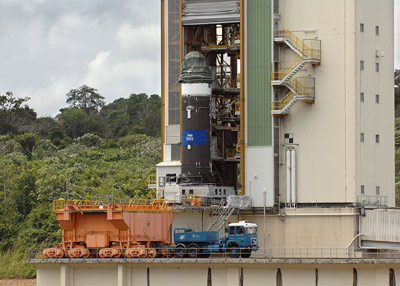 The largest monosegment booster Unlike the EAP’s motor, whose 238-tonne propellant load is cast in three segments which are later assembled together, the P80 features only a single segment with about 88 tonnes of solid propellant. Although this is less than the biggest of the EAP segments, it is far more than any other composite single-segment solid motor ever tested. For comparison, to date the record is held by the motor of the SRB-A booster stage on Japan’s H-2A launcher, with 66 tonnes of solid propellant. The P80’s propellant load was cast some 6 km from the BEAP, at the Guiana Propellant Plant (UPG) where the EAP’s lower segments are also loaded. In fact, the P80 used the same pit. After an initial test with inert propellant in April 2004, real propellant was poured in the first qualification model of the P80 last August. “The propellant is not exactly the same as on the EAP’s”, explains Stefano Bianchi, Vega Programme Manager at ESA. “We adapted the propellant mix and the granulometry to increase its performance and density.”  As for the EAP segments, once the propellant’s polymer binder had solidified, the mandrel forming the exhaust canal for hot gases was extracted and the motor underwent numerous inspections to make sure that no bubbles or cracks had formed inside the binder. In a solid motor, these kinds of defects could have explosive consequences. After inspection, the motor was prepared for its test firing. The P80 is not simply the new motor developed for the first stage of ESA’s Vega small launch vehicle. It is a multidisciplinary demonstrator to validate advanced technologies which could later be applied to Ariane 5’s boosters. Technological advances The most obvious change is to the booster casing. It is made of filament wound graphite epoxy, a technology largely used on smaller motors for civilian launchers as well as ballistic missiles. Much lighter than the stainless steel currently used on Ariane boosters, it provides a dramatic increase in payload capacity. Other improvements in the motor include a new design of igniter with a simplified architecture, also using a carbon-fibre case. The P80 nozzle looks like a shorter version of the EAP nozzle but its design was revised to achieve more simplicity, incorporate fewer elements, and reduce production costs. New thermal insulation material and a narrower throat improve the expansion ratio and overall performance. The new type of flexible joint makes it a lot easier to steer and has allowed the replacement of heavy hydraulic actuators by much lighter electromechanical ones for thrust vector control.  “There are lots of challenges on this test”, says Stefano Bianchi. “As on every maiden firing, there is also a lot to learn.” Preparing for Vega The firing test is planned for 30 November at around 15:00 UTC/GMT (12:00 local time, 16:00 CST/Paris). The timing will depend on wind conditions, to make sure the cloud resulting from the exhaust will not drift over populated areas. The test will last about 100 seconds, with the motor delivering some 200 tonnes of average thrust. Developed under a separate programme managed by an integrated team led by CNES, the French space agency, on behalf of ESA, the P80 is the last of Vega’s motors to undergo static firing. The Zefiro 9 and the Zefiro 23, due to power the third and second stages of ESA’s small launch vehicle, were test fired in December 2005 and June 2006 respectively, at Italy’s test centre in Salto di Quirra, Sardinia. After the 30 November test, it is planned that each of the three motors will undergo an additional static test before the maiden flight of the Vega launcher, which will complement Ariane 5 and Soyuz in the small satellite segment of the launch market.
__________________
Cosmos Pure | Core i7 860 | P7P55D-E Deluxe | 16GB DDR3 Vengeance | HD5850 | 2x850PRO 256GB | 2xRE3 250GB | 2xSpinPoint F3 1TB |
|
|

|
|
|
#175 |
|
Senior Member
Iscritto dal: Nov 2001
Città: Padova
Messaggi: 1635
|
Da SpaceFlightNow.com:
http://www.spaceflightnow.com/news/n0612/06mgs Water may be spurting on Mars NASA NEWS RELEASE Posted: December 6, 2006 NASA photographs have revealed bright new deposits seen in two gullies on Mars that suggest water carried sediment through them sometime during the past seven years. "These observations give the strongest evidence to date that water still flows occasionally on the surface of Mars," said Michael Meyer, lead scientist for NASA's Mars Exploration Program, Washington. Liquid water, as opposed to the water ice and water vapor known to exist at Mars, is considered necessary for life. The new findings heighten intrigue about the potential for microbial life on Mars. The Mars Orbiter Camera on NASA's Mars Global Surveyor provided the new evidence of the deposits in images taken in 2004 and 2005. The images are available here. "The shapes of these deposits are what you would expect to see if the material were carried by flowing water," said Michael Malin of Malin Space Science Systems, San Diego. "They have finger-like branches at the downhill end and easily diverted around small obstacles." Malin is principal investigator for the camera and lead author of a report about the findings published in the journal Science. The atmosphere of Mars is so thin and the temperature so cold that liquid water cannot persist at the surface. It would rapidly evaporate or freeze. Researchers propose that water could remain liquid long enough, after breaking out from an underground source, to carry debris downslope before totally freezing. The two fresh deposits are each several hundred meters or yards long. The light tone of the deposits could be from surface frost continuously replenished by ice within the body of the deposit. Another possibility is a salty crust, which would be a sign of water's effects in concentrating the salts. If the deposits had resulted from dry dust slipping down the slope, they would likely be dark, based on the dark tones of dust freshly disturbed by rover tracks, dust devils and fresh craters on Mars. Mars Global Surveyor has discovered tens of thousands of gullies on slopes inside craters and other depressions on Mars. Most gullies are at latitudes of 30 degrees or higher. Malin and his team first reported the discovery of the gullies in 2000. To look for changes that might indicate present-day flow of water, his camera team repeatedly imaged hundreds of the sites. One pair of images showed a gully that appeared after mid-2002. That site was on a sand dune, and the gully-cutting process was interpreted as a dry flow of sand. Today's announcement is the first to reveal newly deposited material apparently carried by fluids after earlier imaging of the same gullies. The two sites are inside craters in the Terra Sirenum and the Centauri Montes regions of southern Mars. "These fresh deposits suggest that at some places and times on present-day Mars, liquid water is emerging from beneath the ground and briefly flowing down the slopes. This possibility raises questions about how the water would stay melted below ground, how widespread it might be, and whether there's a below-ground wet habitat conducive to life. Future missions may provide the answers," said Malin. Besides looking for changes in gullies, the orbiter's camera team assessed the rate at which new impact craters appear. The camera photographed approximately 98 percent of Mars in 1999 and approximately 30 percent of the planet was photographed again in 2006. The newer images show 20 fresh impact craters, ranging in diameter from 7 feet (2 meters) to 486 feet (148 meters) that were not present approximately seven years earlier. These results have important implications for determining the ages of features on the surface of Mars. These results also approximately match predictions and imply that Martian terrain with few craters is truly young. Mars Global Surveyor began orbiting Mars in 1997. The spacecraft is responsible for many important discoveries. NASA has not heard from the spacecraft since early November. Attempts to contact it continue. Its unprecedented longevity has allowed monitoring Mars for over several years past its projected lifetime.
__________________
Cosmos Pure | Core i7 860 | P7P55D-E Deluxe | 16GB DDR3 Vengeance | HD5850 | 2x850PRO 256GB | 2xRE3 250GB | 2xSpinPoint F3 1TB |
|
|

|
|
|
#176 |
|
Senior Member
Iscritto dal: Nov 2001
Città: Padova
Messaggi: 1635
|
Ottima notizia direi...
NASA Press Release (http://www.nasa.gov/home/hqnews/2006..._Google.html): Dec. 18, 2006 Michael Mewhinney Ames Research Center, Moffett Field, Calif. 650-604-3937 Jon Murchinson Google Inc., Mountain View, Calif. 650-253-4437 RELEASE: 06-371 NASA AND GOOGLE TO BRING SPACE EXPLORATION DOWN TO EARTH MOFFETT FIELD, Calif. - NASA Ames Research Center and Google have signed a Space Act Agreement that formally establishes a relationship to work together on a variety of challenging technical problems ranging from large-scale data management and massively distributed computing, to human-computer interfaces. As the first in a series of joint collaborations, Google and Ames will focus on making the most useful of NASA's information available on the Internet. Real-time weather visualization and forecasting, high-resolution 3-D maps of the moon and Mars, real-time tracking of the International Space Station and the space shuttle will be explored in the future. "This agreement between NASA and Google will soon allow every American to experience a virtual flight over the surface of the moon or through the canyons of Mars," said NASA Administrator Michael Griffin at Headquarters in Washington. "This innovative combination of information technology and space science will make NASA's space exploration work accessible to everyone," added Griffin. "Partnering with NASA made perfect sense for Google, as it has a wealth of technical expertise and data that will be of great use to Google as we look to tackle many computing issues on behalf of our users," said Eric Schmidt, chief executive officer of Google. "We're pleased to move forward to collaborate on a variety of technical challenges through the signing of the Space Act Agreement." Recently, teams from NASA and Google met to discuss the many challenging computer science problems facing both organizations and possible joint collaborations that could help address them. NASA and Google intend to collaborate in a variety of areas, including incorporating agency data sets in Google Earth, focusing on user studies and cognitive modeling for human computer interaction, and science data search utilizing a variety of Google features and products. "Our collaboration with Google will demonstrate that the private and public sectors can accomplish great things together," said S. Pete Worden, Ames center director. "I want NASA Ames to establish partnerships with the private sector that will encourage innovation, while advancing the Vision for Space Exploration and commercial interests," Worden added. "NASA has collected and processed more information about our planet and universe than any other entity in the history of humanity," said Chris C. Kemp, director of strategic business development at Ames. "Even though this information was collected for the benefit of everyone, and much is in the public domain, the vast majority of this information is scattered and difficult for non-experts to access and to understand. "We've worked hard over the past year to implement an agreement that enables NASA and Google to work closely together on a wide range of innovative collaborations," said Kemp. "We are bringing together some of the best research scientists and engineers to form teams to make more of NASA's vast information accessible." NASA and Google also are finalizing details for additional collaborations that include joint research, products, facilities, education and missions. Google's innovative search technologies connect millions of people around the world with information every day. Google is headquartered close to Ames in Silicon Valley with offices through the Americas, Europe and Asia. For more information about Google, please visit: http://www.google.com For information about NASA and agency programs, please visit: http://www.nasa.gov
__________________
Cosmos Pure | Core i7 860 | P7P55D-E Deluxe | 16GB DDR3 Vengeance | HD5850 | 2x850PRO 256GB | 2xRE3 250GB | 2xSpinPoint F3 1TB |
|
|

|
|
|
#177 |
|
Senior Member
Iscritto dal: Nov 2001
Città: Padova
Messaggi: 1635
|
Guy Webster 818-354-6278
Jet Propulsion Laboratory, Pasadena, Calif. Dwayne Brown 202-358-1726 NASA Headquarters, Washington Lori Stiles 520-626-4402 University of Arizona, Tucson Image Advisory: 2007-005 Jan. 11, 2007 New NASA Orbiter Sees Details of 1997 Mars Pathfinder Site The high-resolution camera on NASA's Mars Reconnaissance Orbiter has imaged the 1997 landing site of NASA's Mars Pathfinder, revealing new details of hardware on the surface and the geology of the region. The new image from the orbiter's High Resolution Imaging Science Experiment is available on the Internet at http://www.nasa.gov/mission_pages/MR.../pia09105.html and at links from http://hirise.lpl.arizona.edu. The Pathfinder mission's small rover, Sojourner, appears to have moved closer to the stationary lander after the final data transmission from the lander, based on tentative identification of the rover in the image. Pathfinder landed on July 4, 1997, and transmitted data for 12 weeks. Unlike the two larger rovers, Spirit and Opportunity, currently active on Mars, Sojourner could communicate only with the lander, not directly with Earth. The lander's ramps, science deck and portions of the airbags can be discerned in the new image. The parachute and backshell used in the spacecraft's descent lie to the south, behind a hill from the viewpoint of the lander. Four bright features may be portions of the heat shield. Rob Manning, Mars program chief engineer at NASA's Jet Propulsion Laboratory, Pasadena, said, "The new image provides information about Pathfinder's landing and should help confirm our reconstruction of the descent as well as give us insights into the landing and the airbag bounces." Dr. Alfred McEwen of the University of Arizona, Tucson, principal investigator for the High Resolution Imaging Science Experiment, said "Pathfinder's landing site is one of the most-studied places on Mars. Making connections between this new orbital image and the geological information collected at ground level aids our interpretation of orbital images of other places." For more information on Mars Reconnaissance Orbiter, visit: http://www.nasa.gov/mro . Mars Reconnaissance Orbiter is managed by JPL for NASA's Science Mission Directorate, Washington. JPL is a division of the California Institute of Technology in Pasadena. Lockheed Martin Space Systems, Denver, is the prime contractor for the project and built the spacecraft. The High Resolution Imaging Science Experiment is operated by the University of Arizona, and the instrument was built by Ball Aerospace and Technology Corp., Boulder, Colo. - Da SpaceRef.com (http://www.spaceref.com/news/viewnews.html?id=1185): NASA Decides That A Software Error Doomed The Mars Global Surveyor Spacecraft Keith Cowing Wednesday, January 10, 2007 During a meeting of the Mars Exploration Program Analysis Group Meeting in Washington Dc, yesterday, NASA's John McNamee, Mars Exploration Program addressed the issue of the recent failure of the Mars Global Surveyor (MGS) spacecraft. Apparently incorrect software doomed the spacecraft. MGS stopped operating shortly after celebrating its tenth anniversary. According to public comments made by McNamee: "We think that the failure was due to a software load we sent up in June of last year. This software tried to synch up two flight processors. Two addresses were incorrect - two memory addresses were over written. As the geometry evolved, we drove the [solar] arrays against a hard stop and the spacecraft went into safe mode. The radiator for the battery pointed at the sun, the temperature went up, and battery failed. But this should be treated as preliminary."
__________________
Cosmos Pure | Core i7 860 | P7P55D-E Deluxe | 16GB DDR3 Vengeance | HD5850 | 2x850PRO 256GB | 2xRE3 250GB | 2xSpinPoint F3 1TB |
|
|

|
|
|
#178 | |
|
Senior Member
Iscritto dal: Nov 2003
Città: Utopia Planitia
Messaggi: 3850
|
Betelgeuse rischia il kaboom
 Quote:
__________________

|
|
|
|

|
|
|
#179 | |
|
Senior Member
Iscritto dal: Apr 2006
Messaggi: 1464
|
Quote:
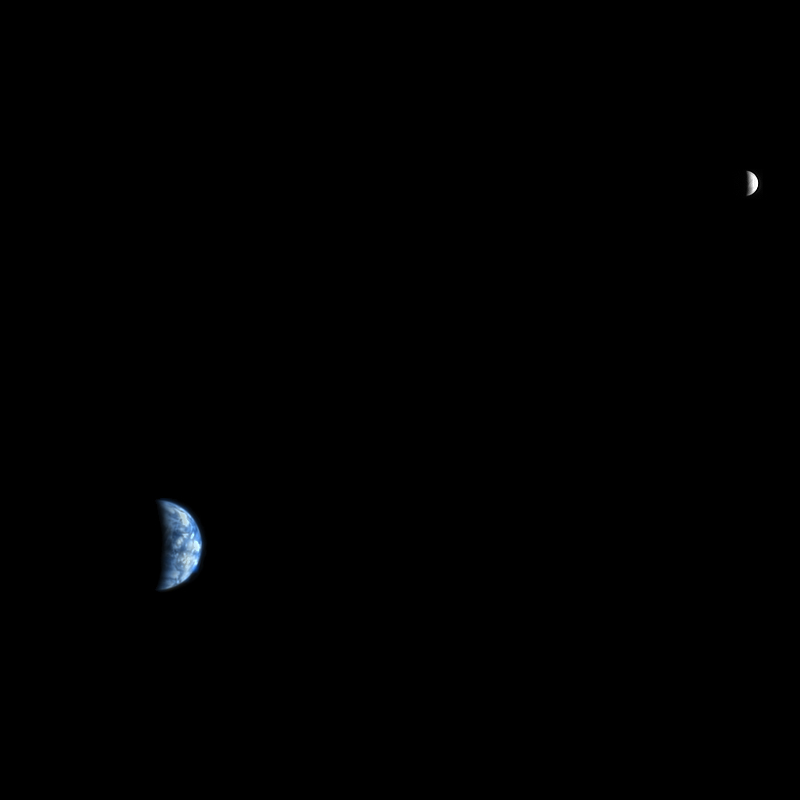
|
|
|
|

|
|
|
#180 |
|
Senior Member
Iscritto dal: Apr 2006
Messaggi: 1464
|
Segnalo le nuove foto restaurate dal Lunar Orbiter Image Recovery Project. Per essere immagini provenienti da sonde degli anni 60 hanno una qualità notevole:
|
|
|

|

|
| Strumenti | |
|
|
Tutti gli orari sono GMT +1. Ora sono le: 10:27.















